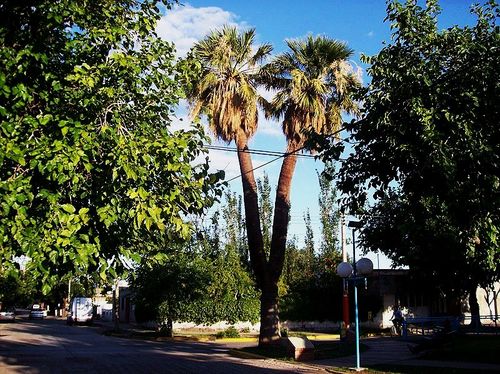Washingtonia filifera
| Washingtonia (Washing-tohn-EE-ah) filifera (fih-lih-FEHR-ah) | |||||||
|---|---|---|---|---|---|---|---|
 Joshua Tree national Park, California. Photo by Dr. William J. Baker, Royal Botanic Gardens, Kew/Palmweb. | |||||||
| Scientific Classification | |||||||
| |||||||
| Synonyms | |||||||
|
| |||||||
| Native Continent | |||||||
|
| |||||||
| Morphology | |||||||
| |||||||
| Culture | |||||||
|
| |||||||
| Survivability index | |||||||
|
| |||||||
| Common names | |||||||
|
| |||||||
Contents
Habitat and Distribution
Washingtonia filifera is found in Arizona, California, Florida, Hawaii, Mexico Northwest, Nevada, and New South Wales in Australia. California fan palm grows naturally in desert and arid regions, along streams and canyons, and in open areas where groundwater is present in southern California, western Arizona, and Baja California in Mexico.Description
Stately and distinctive, the California fan palm is one of the most widely grown palms in subtropical climates. California fan palm can grow 60 ft (18.3 m) tall with a crown spread of 15 ft (4.6 m). The massive gray trunk is barrel shaped and ringed with old leaf scars, and may reach over 3 ft (0.9 m) in diameter at its widest point. California fan palm can have up to thirty gray-green palmate (fan-shaped) leaves, each 3-6 ft (0.9-1.8 m) across. They spread out to form a loose and open crown. The petioles (leaf stems) of mature palms are armed along the margins with curved thorns; those of young palms are largely unarmed. The individual leaflets are pendulous and swing freely in the wind. Abundant cotton-like threads on and between the leaflets persist even when the palm is mature. If old leaves are not removed, they form a continuous "petticoat" from the crown all the way to the ground. The California fan palm produces numerous branching flower clusters that project out and often downward from the leaf crown. The bisexual blossoms are white and yellow and give rise to oblong or round red-black fruit, each about a 0.5 in (1.3 cm) in diameter. The fruits of California fan palm contain a single seed, approximately 1/4 in (0.6 cm) in diameter. (Floradata.com) Editing by edric.
Stems: Solitary, columnar, upright to 15 m tall and 100-150 cm diameter, covered with a skirt of marcescent leaves (unless removed for landscape appeal). Old leaf bases usually fall away after many years, to leave a smooth gray stem with closely spaced leaf scar rings. Leaves: Costapalmate, induplicate, split about half the blade length into numerous segments with pendulous tips and threads (marginal fibers) hanging between segments. Several grayish-green leaves form an open crown. Petioles split, armed with curved teeth. The base of the lower surface of the leaf blade scantly covered with near white pubescence. The adaxial hastula is prominent with tattered margins. Flowers and fruits: Inflorescences are numerous, branched to at least three orders, and project from the crown extending beyond the leaves. Individual flowers are bisexual, white. Fruits are spherical to pear-shaped, up to 1 cm in diameter, and brownish-black to black when ripe. (idtools.org)
Field: Solitary, columnar, upright to 15 m tall and 100-150 cm diameter, covered with a skirt of marcescent leaves. Washingtonia filifera has an open crown of grayish green, costapalmate leaves with armed petioles split at the base. (idtools.org)
May be confused with: Washingtonia robusta, but that species has a tapered stem, roughly twice as wide at the base as the apex, and bright green leaves forming a dense crown, rather than the columnar stemmed W. filifera, with grayish-green leaves and long petioles forming an open crown. (idtools.org)
Culture
This widely grown palm succeeds admirably in a wide range of soils and climates. California fan palm can grow in extreme alkaline soils that have a pH as high as 9.2. Even large California fan palms can be successfully transplanted. California fan palms respond very well to fertilizer. A slow release fertilizer may be used during the summer growing season. Some growers fertilize their palms monthly with a general purpose plant food or a plant food specifically formulated for palms. One enthusiast used a monthly application of Miracle Grow fertilizer to grow a California fan palm with a trunk diameter of 40 in (101.6 cm) - the largest known. The vigorous and robust California fan palm is considered very disease and pest resistant, and is quite resistant to lethal yellowing disease. As with other palms, potassium and magnesium deficiencies may occur in California fan palms and mineral supplements should be administered in recommended amounts to prevent or treat such deficiencies.
Light: California fan palm prefers exposure to full sun and even quite small specimens will thrive in full sun. It also grows well in part sun/shade.
Moisture: Once established, California fan palm is drought tolerant, but it benefits greatly with regular watering. For optimal growth, soil should be moist with good drainage.
Hardiness: USDA Zones 8B - 11. Established California fan palms can withstand frosts and freezes. Reports of cold hardiness for the California fan palm indicate the tree withstands 15 to 20ºF (-9.4 to -6.7ºC) with only minor foliage damage. Many enthusiasts are now growing and recommending the California fan palm in USDA Zone 8A. Mature and established plants have survived -11º F (-11.7ºC), but such very low temperatures can be expected to cause major and significant foliage damage. Palms in fast-draining soil are more cold hardy. During the winter, leaves may become temporarily discolored by damp cold and frost. California fan palms can withstand extreme heat, too, including temperatures up to 127ºF (52.8ºC).
Propagation: California fan palm is easy to grow from seed. Even old seeds are reported to germinate well. Germination is considered so easy that young plants may become weeds under mature palms. (Floradata.com)
Hardy to about 10 deg. F. in the desert, ours have come back from 15 deg. with no damage, native to Ca. deserts, will eventually be a 50 ft. tree, very stout trunk. This is more beautiful than the palms that are usually planted in southern California It would be nice growing near a spring in the desert areas.It is alkali tolerant. If planted together in desert areas they provide an unsurpassed deep, cool shade for a large estate. Washingtonia filifera tolerates alkaline soil, sand and seasonal flooding. (laspilitas.com)
Comments and Curiosities
Uses: The fruit of the fan palm was eaten raw, cooked, or ground into flour for cakes. The Cahuilla and related tribes used the leaves to make sandals, thatch roofs, and baskets. The stems were used to make cooking utensils. The Moapa band of Paiutes as well as other Southern Paiutes have written memories of using this palm's seed, fruit or leaves for various purposes including starvation food.
Historically, natural oases are mainly restricted to areas downstream from the source of hot springs, though water is not always visible at the surface. Grazing animals can kill young plants through trampling, or by eating the terminus at the apical meristem, the growing portion of the plant. This may have kept palms restricted to a lesser range than indicated by the availability of water. Today's oasis environment may have been protected from colder climatic changes over the course of its evolution. Thus this palm is restricted by both water and climate to widely separated relict groves. The trees in these groves show little if any genetic differentiation, (through electrophoretic examination) suggesting that the genus is genetically very stable.
| read more |
|---|
|
"This is a very commonly grown palm in California, from the coast to far inland. It is native to the more inland areas, and the more inland it is grown, the better it tends to look. Those palms grown on the coast, where they get a lot more moisture than they should, often have pinched trunks and very small, sad looking crowns. Those growing in the desert have huge, beautiful crowns and nice, thick trunks. Commonly confused with the even more common Mexican Fan Palm (Washingtonia robusta), this one can be distinguished by the thicker, nearly always straight trunk-- the crown is also larger and relatively sparser. The leaves a more sea green, as opposed to the deep green of the Mexican fan palm. The petioles are always green--no red or brown in the petioles as there always is in the Mexican palms. It is a slower grower and seems to top out at around 60', while the Mexican palms can get up to 100' tall. Interspecies hybrids are extremely common, however (may even be the most common palms growing in southern California) and tend to have a bit of characteristics of both palms- thick trunks, but full heads and red on the petioles. Some palm researchers consider these two the same species, too. It is also commonly confused with Brahea edulis, another common avenue palm in southern California. They both tend to have thick, naked trunks and pale green leaves, but the latter has a much denser crown of leaves that have many more pleats to them. Flowers a very different, with the Washingtonia flowers extending noticeably beyond the leaves. The bushier, yellow flowers of the Braheas are shorter than the leaves and tend to be located among the uppermost leaves (Washingtonia flowers stick out in all directions, top to bottom of crown). Seeds of Washingtonia are smaller than peas, while those of Braheas are larger than grapes." (Geoff Stein) |
- IMAGE GALLERY
External Links
- Glossary of Palm Terms
- MODERN BOTANICAL LATIN
- "Just To Be Clear"
- http://hort.ifas.ufl.edu/database/documents/pdf/tree_fact_sheets/WASFILA.pdf
- http://www.fs.fed.us/database/feis/plants/tree/wasfil/all.html
- http://www.calflora.org/cgi-bin/species_query.cgi?where-taxon=Washingtonia+filifera
- http://www.floridata.com/ref/w/wash_fil.cfm
- http://idtools.org/id/palms/palmid/factsheet.php?name=Washingtonia+filifera
References
Phonetic spelling of Latin names by edric.
Special thanks to Geoff Stein, (Palmbob) for his hundreds of photos.
Special thanks to Palmweb.org, Dr. John Dransfield, Dr. Bill Baker & team, for their volumes of information and photos.
Glossary of Palm Terms; Based on the glossary in Dransfield, J., N.W. Uhl, C.B. Asmussen-Lange, W.J. Baker, M.M. Harley & C.E. Lewis. 2008. Genera Palmarum - Evolution and Classification of the Palms. Royal Botanic Gardens, Kew. All images copyright of the artists and photographers (see images for credits).
Many Special Thanks to Ed Vaile for his long hours of tireless editing and numerous contributions.







































































